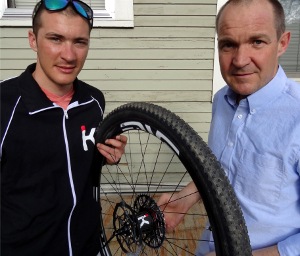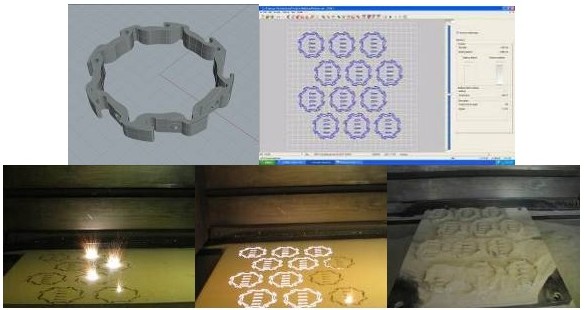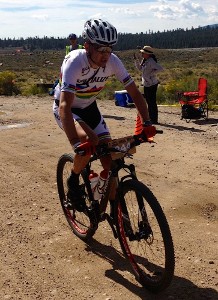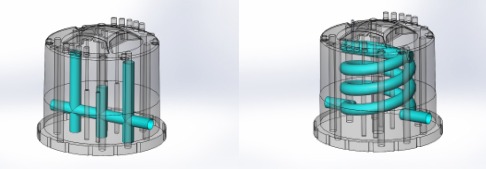 |
| May 07, 2013 | Volume 09 Issue 17 |
Designfax weekly eMagazine
Archives
Partners
Manufacturing Center
Product Spotlight
Modern Applications News
Metalworking Ideas For
Today's Job Shops
Tooling and Production
Strategies for large
metalworking plants
Wheels:
Cyclists take industrial 3D printing for a spin
Kappius Components uses laser sintering for trailblazing bike hub/drive assembly
By Chris Hardee

Russell Kappius, developer of the Kappius hub, and his son, Brady, professional mountain-bike racer, outside their garage-shop. [Image courtesy: Kappius Components]
To American inventors, the "home garage" has always been a symbol of possibility -- a place for tinkerers to create and innovate. More than a century ago, the Wright brothers founded a cycle sales and repair business from a modest storefront and soon after invented a bike hub that was self-oiling. Everyone knows what they did next in the field of aviation.
Harley Davidson's motorized bikes were born in a backyard shed. HP's Hewlett and Packard and Apple's Jobs and Wozniak helped define the modern computer age from their suburban startup shops. And garage-based entrepreneurs are still at it in the 21st century.
About four years ago, Russell Kappius -- mountain-bike enthusiast, winner of six Masters racing titles, and a research geophysicist/software developer -- became obsessed with bicycle hubs. He wanted more speed and responsiveness, but wasn't sure how to get it.
His 'Aha!' moment came when a demo part from one of the bicycle industry's major suppliers arrived in the mail. "When I saw it, I got an idea for a new hub-drive system," says Kappius, "I did a patent search and quickly learned that there wasn't anything out there that covered what I was thinking."
After working out a design for a novel oversized hub and high-performance drive assembly that would transfer more power from pedal to chain to wheel, Kappius patented the concept and began looking for a way to fabricate the parts.
The manufacturing conundrum
One barrier to entrepreneurial success in any age is finding an efficient, cost-effective, and fast route from product idea to physical product. Kappius first knocked on the door of a fabricator who offered water-jet cutting, a technique often used to make machine parts out of extremely hard metals. But the process was limited in its capacity to produce dimensionally accurate and complex parts. Next, he tried wire electrical discharge machining (WEDM), a technology that can cut intricate shapes in hardened steel. This method, while producing parts that met specifications, had a fairly long turnaround time and could only fabricate 2.5D geometries, a constraint to component shape. With no better option available at the time, he settled on this technique.
For two years, Kappius and his son, Brady (an engineer and pro mountain-bike rider), field-tested versions of their hub and tweaked its design. "Because we're a startup, we quickly learned that we needed to make design changes and get new parts out to our customers fast," the elder Kappius says. "We had to leverage our time to market to stay competitive."
Then in late 2011, Kappius discovered direct metal laser sintering (DMLS), an additive manufacturing ("3D printing") technology that met their rapid turnaround needs and enabled them to produce parts to exacting specifications and with additional design complexity. He also located Harbec -- an Ontario, New York-based DMLS provider -- and sent them a CAD file that included the latest round of design refinements.
About 30 days later, the father-son team received new parts. And in the first week of field testing, the elder Kappius won a race using the latest hub assembly. "We went from concept to bike-ready components in about a month," he says. "I've never been able to move that quickly before."
Laser sintering sharpens the competitive edge
Kappius Components' hubs have been through a half-dozen design iterations since the "garage doors" opened for business in 2008. But the recent move to laser sintering has accelerated the speed of improvements. "As a software engineer, I am able to change anything at any time to make the code better," says Kappius. "With DMLS, I have similar flexibility. It allows me to make small design changes and almost immediately test them on the bike. That's the beauty of the technology."
The beauty of the lightweight-yet-durable hub, on the other hand, comes from the sleek carbon-fiber shell (handmade by the younger Kappius), as well as the drive assembly housed inside it. The assembly is comprised of three major parts: an outer drive ring, an inner ring with 60 teeth, and eight pawls (or flippers), which engage in pairs with the teeth on the inner ring. This setup functions like a ratchet (as in other drivetrains), allowing forward motion while preventing backward motion.

The Kappius rear hub is a groundbreaking lightweight, durable, oversized design (left). Its carbon-fiber housing, which interfaces with a commercially available gear cassette, contains a drivetrain assembly comprised of three components including an inner pawl ring (center, gray), a toothed drive ring (right), and pawls (not shown). The components are all manufactured from an extremely durable "tool steel" using direct metal laser sintering (DMLS). [Images courtesy: Kappius Components & Ben Delaney/BikeRadar]
The technological advance in the system comes from two developments: the oversized design -- it's about twice the current standard diameter -- and many more points of engagement than standard designs. These two features constitute the heart of the hub's intellectual property and allow a cyclist to translate the act of pedaling into increased drive force (see sidebar, "A brief history of hub innovation").
When he first geared up for business, Kappius bought ready-made pawls and engineered the rest of his system around them. Once he discovered laser sintering, however, he was able to redesign the pawl itself and add a 1-mm cylindrical basal extension, which positioned them better when they engaged.
Laser sintering's advantage over other fabrication methods is the ease with which it can manufacture cylindrical and other irregularly shaped parts, like Kappius' pawls. Since it's an additive rather than subtractive process, the technology "grows" parts layer by layer using powdered materials (metals, polymers, and foundry sands) that are heated and melted by a laser. The beam follows the outlines and contours of a series of cross-sectional slices taken from a 3D digital model.

This image series shows the progression from CAD to direct metal laser-sintered (DMLS) parts for the Kappius hub's drive assembly: a 3D CAD model (top left) is used to guide the sintering operation in an EOSINT M 270 system; a screenshot from the system's PSW software (top right) illustrates how parts are laid out on the build platform; a 200-W laser melts the powdered maraging steel (bottom left and middle), joining one layer to the next; and the finished parts are covered in excess steel powder (bottom right), which is removed using compressed air and recycled before final machining and heat treating. [Images courtesy: Harbec]
"There is no way we could have improved our pawl design using wire EDM because that method cuts parts out of flat pieces of metal," says Kappius. "DMLS has freed us up to make improvements on all of the elements in the system." The technology has also helped level the playing field between Kappius' two-person company and the bigger players in the bicycle industry.
Small-lot manufacturing -- just in time
At subcontractor Harbec, where Kappius components are manufactured, Keith Schneider and Jeremiah Wackerman are in charge of the laser-sintering operation. A typical order of 10 drivetrain assemblies requires two builds on Harbec's EOSINT M 270, a DMLS system from German-based EOS GmbH, the developer of the technology. Experienced operators working with manufacturing software arrange the components on the machine's build platform to maximize output: 10 outer rings, 10 inner rings, and 80 pawls (eight for each assembly), plus a few extras.
Since durability was of prime importance for the application, Kappius selected maraging steel -- a heat-treatable metal with excellent hardness and strength -- from the available materials. Run time is around 25 hours per plate, or 50 hours total for 10 assemblies. "It's a pretty straightforward build," says Schneider.
Following the run, the parts are removed from the laser-sintering unit, machined, and heat-treated -- all in-house. On a CNC mill, the manufacturing support structures are removed and an extra twenty-thousandths of material from the back side of the part (added during manufacturing) is planed down. This creates a machined finish. "We use this approach when parts have moving interfaces, such as in this hub or with bearings and bushings," says Wackerman. "It gives us a really clean surface without imperfections."
The components are then moved to Harbec's kiln and hardened to a value of 52 Rockwell C. "We've done quite a bit of R&D on maraging steel," says Wackerman. "We have a heat-treatment method where we are able to minimize any movement, shifting, or warpage and maintain precise dimensions while still getting the hardness that we want. That's pretty unique."
Kappius is pleased with the results. "The tool steel is super strong," he says. "I haven't had a single hub failure. Even the big manufacturers can't say that."
And with Harbec supplying parts on an as-needed basis, the father-son team assembles components in their home shop after hours and ships them out to early-adopter cyclists around the world. Production is accelerating fast for the young company -- they sold about 100 hub assemblies this past year and are projecting sales of 500 in 2014.
Finishing strong
As a plastics injection molder, tool builder, prototyper, and machine shop, Harbec complemented its traditional manufacturing capabilities by adding DMLS about five years ago. The biggest impact to date, according to Schneider, has been on their injection molding business, where laser sintering has substantially increased design freedom and improved manufacturing efficiencies (see sidebar, "The beautiful marriage of mold making and DMLS").
Being an additive process, DMLS has also likely saved them considerable material on machining projects, says Schneider, even though they haven't yet quantified the results. The company has measured significant savings on their electrical consumption in a study comparing sintering technology to EDM. All of these benefits are important to Harbec's president, who is committed to making the company both economically and environmentally sustainable.
The benefits of DMLS for the bike-hub creator? "Number one is design freedom," says Kappius. "Number two is the material strength. Three is lead time."
And then there's also the rider experience. "People just love the hub," says Kappius. "They're faster and fun to ride."
A brief history of hub innovation (sidebar 1)
According to Russell Kappius, founder of bike-hub-manufacturer Kappius Components, after flat tires and broken chains, a damaged hub is the third commonest way a bike can fail when you're out on the trail or road. "If you break a hub, it's a show-stopper," he says.

Swiss-born cyclist Christoph Sauser, the 2012 cross-country world champion, won the Swiss national title using the Kappius hub design. [Image courtesy: Kappius Components]
Kappius is also eager to describe how every bicycle component has advanced toward lighter materials and oversized designs in the last quarter century -- except the hub and drive assembly. "In general, hubs used a free-wheel assembly for the rear gear cluster up until the mid-1980s," says Kappius. Then the biggest manufacturer in the industry introduced a new integrated free hub, which was an improvement but also forced the industry into a small form factor for the drive system. We've all adhered to that standard for the last 25 years." Until now.
"My hub breaks the rule and uses an oversized interface," Kappius adds. It's also built around a drivetrain with more points of engagement (240) in a single revolution of the wheel than what is found in the next closest competitor (120), as well as in most other standard drive trains (18-36). In the Kappius product, the pedal can engage every 1.5 degrees and give the rider an extra quarter- or half-pedal stroke, which is great for racing and highly technical riding.
As Kappius further explains, there are approximately 100 hub manufacturers in the bicycle industry, but there are only four or five different drives. "Our drive assembly is a critical innovation," he says. Seconding that sentiment is "Bicycling" magazine, which included Kappius hubs on the timeline of noteworthy bicycle innovations in their 50th anniversary issue (November, 2011).
The beautiful marriage of mold making and DMLS (sidebar 2)
"Our primary business is plastics injection molding," says Keith Schneider, DMLS expert at Harbec. "We got into direct metal laser sintering because our owner was interested in building mold cavities and mold cores using this technology."
Three factors inherent in the technology influenced their decision: a decrease in waste as compared with subtractive CNC processes, faster production of molds, and the design flexibility that sintering provides tool designer/mold makers for conformal cooling strategies.
Because DMLS can create extremely complex geometries, laser-sintered cooling channels are able to closely follow the contours of the mold's cavity surfaces. This increases the surface area of the channels and improves the efficiencies of the cooling process. It's a simple principle: When channels conform closely to the product, the part cures more evenly and the cure time is reduced.

These CAD-based images show a conventional machined steel core with straight channels (left) and a conformally cooled core with spiral cooling channels (right), which was manufactured using DMLS. In a test performed by Harbec of different curing times and part shrinkage after ejection from the mold, it was shown that the part was able to be cured more quickly using the conformal curing core while achieving dimensions that more accurately met specifications. In injection molding operations running hundreds of thousands of parts annually, if cure times can be reduced, even by seconds, cycle times follow, allowing for faster production turnaround times and reduced cost. [Images courtesy: Harbec]
"The bulk of the cost of injection molding comes from the time parts spend cooling in the mold," says Schneider. "DMLS has allowed us to dramatically reduce cycle times and improve the economics of part manufacture for our customers."
Learn more about EOS additive manufacturing solutions by clicking here.
Published May 2013
Rate this article
View our terms of use and privacy policy
